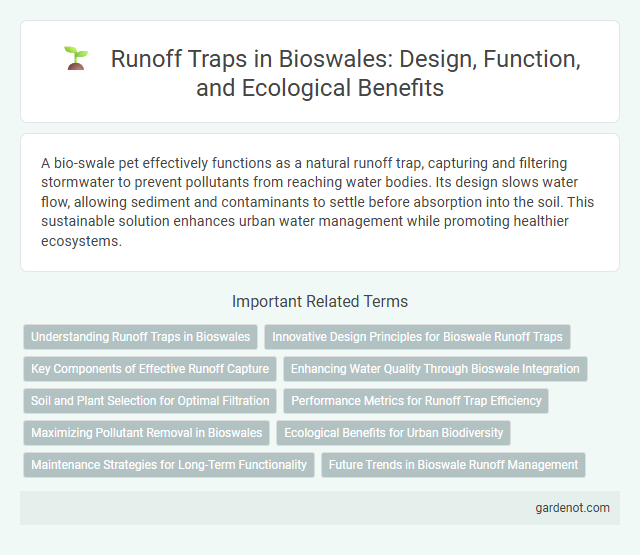A bio-swale pet effectively functions as a natural runoff trap, capturing and filtering stormwater to prevent pollutants from reaching water bodies. Its design slows water flow, allowing sediment and contaminants to settle before absorption into the soil. This sustainable solution enhances urban water management while promoting healthier ecosystems.
Understanding Runoff Traps in Bioswales
Runoff traps in bioswales function as critical elements designed to capture and temporarily hold stormwater, preventing pollutants from entering water bodies. These structures enhance sedimentation and filtration processes, improving water quality by allowing contaminants and debris to settle before water infiltrates the ground. Effective runoff traps contribute to reducing urban flooding and promoting groundwater recharge within stormwater management systems.
Innovative Design Principles for Bioswale Runoff Traps
Innovative bioswale runoff traps integrate permeable materials and vegetation layers that enhance water infiltration and pollutant capture, reducing surface runoff volume and improving water quality. Strategic placement of bio-retention cells and engineered check dams within the bioswale directs flow and maximizes sediment deposition, preventing clogging and promoting sustained filtration. Advanced design principles emphasize adaptive maintenance access and modular construction to optimize performance in diverse urban and suburban landscapes.
Key Components of Effective Runoff Capture
Effective runoff capture in bio-swales hinges on key components such as a properly graded surface to direct stormwater efficiently, engineered soil media that promotes infiltration and pollutant removal, and strategically placed vegetation to slow water flow and enhance filtration. Incorporating check dams or flow spreaders helps distribute runoff evenly, minimizing erosion and maximizing absorption capacity. The integration of underground drainage systems further ensures controlled water retention and gradual release, preventing overflow and downstream flooding.
Enhancing Water Quality Through Bioswale Integration
Runoff traps integrated within bioswales significantly enhance water quality by capturing sediments, pollutants, and nutrients before runoff reaches natural water bodies. These traps promote sedimentation and filtration, reducing contaminants such as heavy metals, oils, and organic matter in stormwater. Implementing bioswale runoff traps supports sustainable urban drainage systems, contributing to improved ecosystems and reduced pollution loads.
Soil and Plant Selection for Optimal Filtration
Selecting the right soil composition and plant species is crucial for maximizing runoff filtration in bio-swales. Sandy loam soils with high permeability enhance water infiltration and support microbial activity that breaks down pollutants. Native plants with deep root systems improve soil structure, increase nutrient uptake, and provide effective sediment trapping, leading to superior runoff treatment performance.
Performance Metrics for Runoff Trap Efficiency
Runoff trap performance metrics primarily assess pollutant removal rates, flow retention capacity, and sediment capture efficiency. Key indicators include total suspended solids (TSS) reduction percentage, peak flow attenuation, and heavy metal concentration decrease in trapped runoff. Reliable data collection entails comparing influent and effluent water quality during storm events to quantify effectiveness.
Maximizing Pollutant Removal in Bioswales
Runoff traps in bioswales are engineered to maximize pollutant removal by enhancing sedimentation and filtration processes. Incorporating materials like compost and engineered soil media increases nutrient uptake and pollutant degradation efficiency. Optimized flow control within the runoff trap ensures prolonged water retention time, improving the removal of heavy metals, hydrocarbons, and suspended solids.
Ecological Benefits for Urban Biodiversity
Runoff traps in bio-swales enhance urban biodiversity by filtering pollutants and providing clean water that supports diverse plant and animal species. These features create microhabitats for pollinators, amphibians, and beneficial insects, contributing to ecosystem resilience in city environments. By reducing surface runoff and improving water quality, runoff traps help restore natural hydrological cycles and promote sustainable urban ecosystems.
Maintenance Strategies for Long-Term Functionality
Regular inspection and removal of debris are essential for maintaining the effectiveness of runoff traps in bio-swales. Implementing a scheduled cleaning routine to clear accumulated sediment and organic matter prevents clogging and supports consistent water infiltration. Employing preventive measures such as vegetation management and erosion control enhances the longevity and performance of bio-swale runoff traps.
Future Trends in Bioswale Runoff Management
Future trends in bioswale runoff management emphasize the integration of smart sensors and IoT technology to monitor water quality and flow rates in real-time, enhancing the efficiency of runoff trapping. Advances in green infrastructure design incorporate native vegetation and porous materials that improve infiltration and pollutant removal, supporting sustainable urban drainage systems. Emerging practices also include adaptive maintenance protocols based on predictive analytics, optimizing bioswale performance and longevity under varying climatic conditions.
Runoff trap Infographic

 gardenot.com
gardenot.com